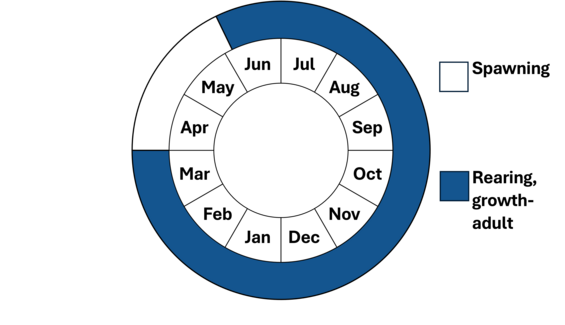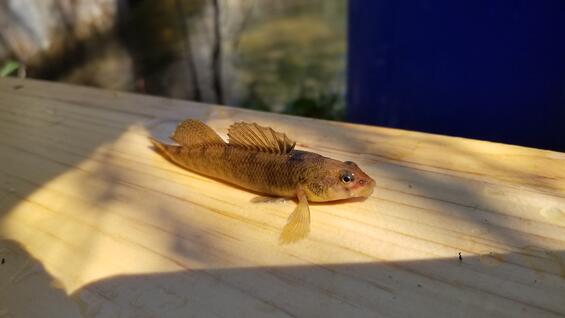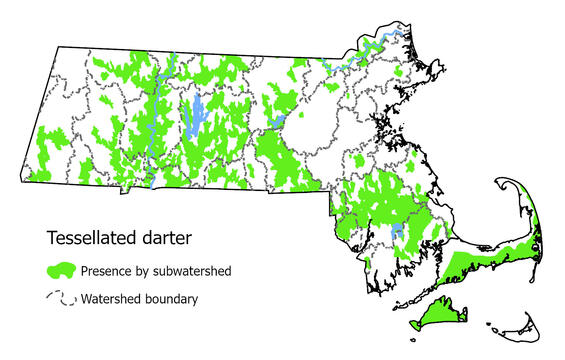- Scientific name: Etheostoma olmstedi
- Species of Greatest Conservation Need (MA State Wildlife Action Plan)
Description

Tessellated darter (Etheostoma olmstedi)
The tessellated darter has a continuous lateral line along the mid-body that does not arch upward and also has a single anal spine. Non-breeding specimens are sandy-tan with several dark saddle-like marks and 9 to 10 dusky, lateral spots that often suggest the letters X, Y, or Z. Males usually have a dark blotch on the membrane between the first and second dorsal spines, and when breeding, become quite dark and develop swollen white tips on the pelvic fins. Adults are usually 2 to 3 inches long, occasionally reaching 4 inches. This fish often sits motionless, propped up on its pelvic fins, on the bottom or on rocks, then makes abrupt, quick darts when feeding or disturbed. The species is short-lived, and most individuals die after their third summer, although a few survive into their fourth winter. Tessellated darters feed mainly on the larvae of midges and other flies; however, they may switch to other prey, such as caddisflies, later in the season.
Life cycle and behavior

Tessellated darters spawn in April and May in shallow streams with rocky bottoms. Males establish spawning territories and defend nests. Females lay 30-200 eggs. After eggs are released and fertilized, males guard and fan nests to keep water circulating over the eggs. Eggs hatch in 5-8 days.

Tessellated Darters collected during a survey in May. Note the enrichment of colors, such as the orange tail, yellow belly, and darker “X” or “W” marks, during spawning.
Population status
The population status, although generally unassessed, appears to remain healthy and stable. Tessellated darters are common and numerous in most rivers where they occur throughout the state.

Adult tessellated darter collected from a Cape Cod stream on 5/7/2019.
Distribution and abundance
In Massachusetts, this darter is common in most of the Connecticut and Blackstone River basins in the southeastern parts of the state, and on Martha's Vineyard. It is rare in the northeast drainages, where only a few specimens have been found in the Merrimack River Drainage. This darter is absent from the Hoosic, upper Deerfield, Charles, and Nantucket drainages. Darters are common in New England states and Atlantic states from New York south to Georgia, as well as parts of Florida.

Data from 1999-2024 from annual surveys.
Habitat
The tessellated darter prefers moving water and, unlike the swamp darter, is seldom if ever found in lakes or ponds in Massachusetts. It frequents areas with rubble, sand, or mud bottoms that usually have some vegetation. Underwater objects, usually rocks or logs, are required for spawning.
Healthy habitats are vital for supporting native wildlife and plants. Explore habitats and learn about conservation and restoration in Massachusetts.
Threats
Pollution, stream flow alteration or other alterations to its habitats appear to be the major threats to this species.
Conservation
Protecting and restoring river and stream habitats would aid in the conservation of tessellated darters.
Surveying and monitoring
Tessellated darters are collected and monitored during standard fisheries surveys of rivers and streams where they occur.
Management
No specific management plans for tessellated darters exist.
Research needs
A better understanding of habitat requirements and life history traits may assist the management and assessment of populations.
References
This species description was adapted, with permission, from: Karsten E. Hartel, David B. Halliwell, and Alan E. Launer.
2002. Inland Fishes of Massachusetts. Massachusetts Audubon Society, Lincoln, Massachusetts.
Contact
| Date published: | April 10, 2025 |
|---|